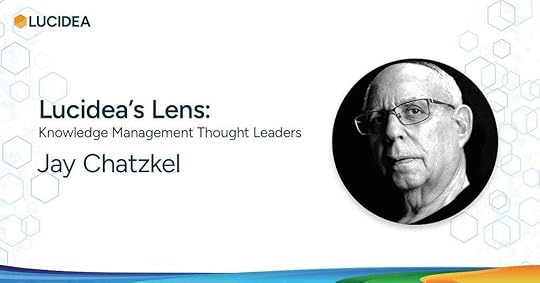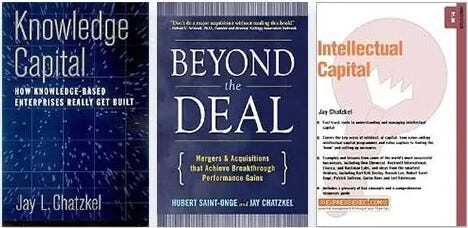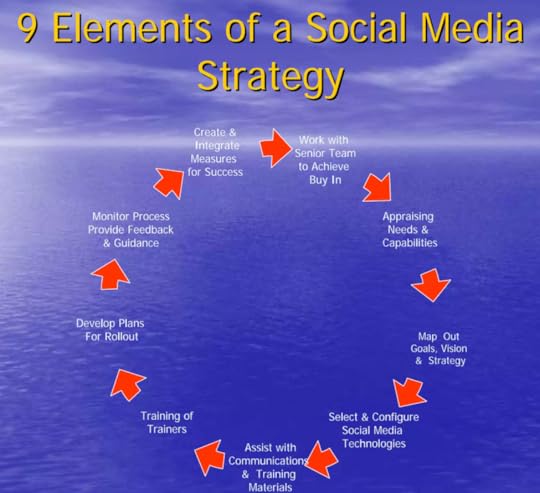Knowledge Management Thought Leader 128: Jay Chatzkel

Jay Chatzkel was Principal of Progressive Practices, where he assisted organizations in transforming themselves into knowledge-based, intelligent enterprises. This included working with organizations to develop skills and practices in the areas of merger and acquisition integration, intellectual capital, knowledge management, social media, leadership, collaboration, business process management, and performance measurement.
He served on the editorial boards of the Journal for Knowledge Management, the Journal of Intellectual Capital, and the International Journal of Knowledge-Based Development and has written extensively in the field. He is the author of three books. He specialized in intellectual capital, knowledge capital, mergers and acquisitions, knowledge management, business process reengineering, and quality management.
Here are definitions for five of Jay’s specialties:
Business Process Management : A discipline that uses various methods to discover, model, analyze, measure, improve and optimize business processes. A business process coordinates the behavior of people, systems, information and things to produce business outcomes in support of a business strategy. Collaboration : Interacting with peers and colleagues to exchange ideas, share experiences, work together on projects, and solve problems. Intellectual Capital : The sum of everything everybody in a company knows that gives it a competitive edge. A metric for the value of intellectual capital is the amount by which the enterprise value of a firm exceeds the value of its tangible (physical and financial) assets. It includes human, structural, and relational capital.Knowledge Capital: Knowledge resources mobilized to produce wealth. Knowledge Capital bridges the differences between knowledge management (the flow of knowledge) and intellectual capital (the stock of knowledge). Knowledge is the resource and capital is the generated wealth. Social Media : Web- and mobile-based technologies used to turn communication into interactive dialogue among organizations, communities, and individuals.Jay created the following content. I have curated it to represent his contributions to the field. or more about Jay, see Profiles in Knowledge.
 Books
Books Knowledge Capital: How Knowledge-Based Enterprises Really Get Built — Preface
Knowledge Capital: How Knowledge-Based Enterprises Really Get Built — PrefaceThe idea for this book began with a conversational interview with one of the foremost theoreticians and practitioners of the knowledge movement. The goal was to quickly and easily get a sense of his understandings, practices, and ideas. In short, the aim was to get a working sense of his world, how he developed his views, and the directions that he saw the field taking. I was taken by the wealth and richness of understanding that emerged in that session. I felt that by holding similar sessions with others who have shaped and led the fields of intellectual capital and knowledge management, a body of knowledge and experience would become available that would be remarkably accessible, extremely powerful, and highly useful.
This is exactly the kind of hard-won knowledge that anyone interested in the fields of intellectual capital and knowledge management could sorely use. People at conferences and those searching through books want to know how things really work and how those ideas and approaches came into being. The conversations in this book provide precisely that kind of knowledge capital: authentic, broadly embracing, clear, and dynamic.
These linked sessions reflect the major learning principles of the field, most centrally, that knowledge is not separate from people. The contributors to these chapters are remarkably candid in sharing with readers how they developed their knowledge strategies and initiatives. They are outspoken in articulating what is important to them concerning how to craft and implement strategies, as well as their views on the roles that values, learning, performance, relationships, innovation, and change play in the development of a usable knowledge environment.
One of the remarkable aspects of this book is that while all of the contributors begin from their own unique perspectives and backgrounds, as they work their way through their experiences and practices, they each move toward a convergence of understanding. As they push the limits of what their understandings allowed them to accomplish, they reexamine their premises, cross boundaries, and forge the next stage of responses. Reaching the edge of what is currently possible has thus led to the marking out of a new generation of the field.
Engineers, like Karl Wiig, are turning their mental model on its head and saying that learning and education are what we need to focus on. Hubert Saint-Onge, who is rooted in a human resources background, sees that the traditional human resources perspective has become too balkanized and obsolete and that we must reframe our efforts to focus on developing strategic capabilities. Stephen Denning, a lawyer with a strong analytic and administrative background, has discovered that storytelling, something that is experiential, often anecdotal, and highly emotional, provides exactly the springboard for knowledge sharing that people and their institutions need. These are fresh and new understandings. The value of this book is that all of these dynamic perspectives are brought directly to the reader for review.
All of these views are, in a sense, works in progress. With the benefit of feedback, ever-broadening experience, and the incorporation of new ideas, these perspectives will go through additional iterations at a rapid pace. This means that all of these conversations could be significantly different three or five years from now, as people continue to experiment in constantly changing conditions. At the same time, these conversations are some of the best collections of insights and experience available to readers, and they are, simultaneously, the seeds of the new era in the knowledge field.
One of the opportunities afforded by this collection of knowledge perspectives is that readers can try them all individually in their own lives and in their organizational work. A second opportunity is that readers can take elements of any or all of these perspectives and fuse them to create their own new and unique approaches. Readers are encouraged to bring this material into a new focus and to synthesize it to meet their needs. This book is designed as the beginning of a conversation on creating knowledge capital, rather than as a set of prepackaged prescriptions, where one size fits all and the world does not change.
Intellectual Capital: Chapter 2Quotes
Because knowledge has become the single most important factor of production, managing intellectual assets has become the single most important task of business — Thomas A. Stewart
The new source of wealth is not material, it is information, knowledge applied to work to create value. — Walter Wriston, former chairman of Citibank
User-Based Definitions
People from a range of backgrounds have, over time, developed the discipline of intellectual capital Because each was dealing with a specific set of issues and problems, their definitions directly reflect their unique perspectives and the very specific sets of problems they were working to resolve. Each of the perspectives they developed is true for its specific user need. Thinking that only one of these definitions is correct and therefore the others are wrong is not accurate or effective. A great deal can be gained by looking at intellectual capital through these different definitions. Each lens gives us an opportunity to see our organizations differently enough to derive greater value than any single definition could provide- All of them are valid and it is up to the user to select the definition that works best to meet any particular set of needs.
A definition of intellectual capital from a managerial perspective is:
the knowledge, applied experience, organizational technology, relationships, and professional skills that provide for a competitive edge in the market.
This is a definition that takes into account the people who make up the organization, the structural dimensions of the organization, and all of the relationships of the organization. Definitions that come from a human resource and organizational development background emphasize that the intangible resources are based on implicit human experiences that must be actively turned into the stuff that provides a competitive advantage for the organization.
A more dynamic version of this definition says that intellectual capital is:
knowledge that can be converted into value or profit. It is the value embedded in the ideas embodied in people, processes, and customers/stakeholders.Social Media Strategy
 [image error]
[image error]



